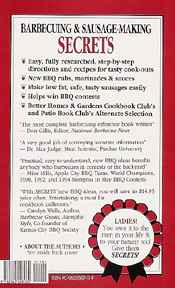
Barbecuing & Sausage-Making Secrets
Culinary Institute of Smoke-Cooking
Charlie & Ruthie Knote
 |
Informative
Interesting Reading
Rewarding
Ideas
Basic & Advanced Techniques
Over 250 Easy & Unique
Recipes
|
 |
This 280 page book is packed with the intricate details behind producing
superb smoked barbecue. One of the must-have tools of the smoking
enthusiast are the Grilling Guides for Charcoal, Gas or Electric Grills.
Included are approximate times for grilling many types of meats and the internal temperatures of the meat for Rare, Medium and Well Done pieces.
An Example:
Cooking Minutes
Meat Type Thick Temp. Rare Med. Well
Pork Loin 1 inch Med. Hot 9-12 12-13 15-18
& 1 1/4 Med. Hot 9-12 12-16 16-20
Rib 1 1/2 Med. Hot 15-18 19-24 12-26
drop to Med
Barbecuing & Sausage-Making Secrets has been written in eight
logical chapters to ease the reader into a complete understanding of the
art of barbecuing great pieces of meat and fish.
Chapter 1: Food Panicked Americans
|  |
Chapter 5: Smoke-Cooking
|
Chapter 2: Why Eat Meats?
| |
Chapter 6: Sausage
|
Chapter 3: Basics of Barbecuing
| |
Chapter 7: Recipes
|
Chapter 4: Grilling
| |
Chapter 8: Why Eat Meats
|
Nottingham has been granted permission to publish several quotes from
Knote's book. In doing so, we have selected several helpful tips which are
not normally known to the occasional cook. We will attempt to secure
permission to use other tips in the future. If you find these selections
helpful, please send us your comments.
Tip #1: MOISTURE RETENTION
Meat's juices contain over 90% water, and water boils away rapidly at
212*F. cooking temperature, and above. Water evaporates even at 120*F. At
150*F. not only do you continue to squeeze out meat's juices, but you also
evaporate more water from the juice itself. A "cookout-masterpiece" starts
with retaining meat's natural juices, including the water in the juices.
Research proves that 14% of the meat's total moisture is lost when its
cooked temperature is raised from 145*F. to 175* -- this can be the
difference between very juicy and dry meats. As long as the bacteria is
controlled at lower temperatures, you may need to rethink desired doneness
temperatures. (Page 9)
Tip #2 HAND/FINGER TEST FOR DONENESS
You use both of your hands. The muscle between your left hand's thumb
and first finger becomes the "meat" (this is for right-handed people).
Hold the left hand very relaxed with its first finger and thumb drooped
and parallel to each other. Use the first finger of your right hand
for your "doneness tester." Push against the "loose" muscle (not the loose
skin) between your thumb and finger on your left hand. This soft feel
compares to the center of your meat if it is raw up to rare
for a rating of 1.0. Next, straighten your thumb and finger out straight,
push against the same muscle. This springy feel equals meat cooked
medium for a rating of 2.0. Next, make a tight fist; test the same
muscle area. This firmness equals meat cooked well-done for a
rating of 3.0. Test knuckle for a rating of 4.0 or overdone. (Page 17)
P.S. Knote highly recommends using an instant read thermometer and cooking according to temperature and not time.
Tip #3 SMOKE FLAVORING AND SMOKE WOODS
The smoke wood flavor of the meats depends upon the darkness of the
smoked color. Smoke woods flavor foods somewhat differently and are a
matter of preference. Hickory flavor has been the old stand-by with dry or
wet wood chunks, shavings or sawdust. Oak, apple, peach alder, cherry,
mesquite, pecan, maple, or combinations are preferred by some. Too much
smoke from any wood can turn meat bitter. Smoke wood flavor ratings:
Alder: (from the West Coast) sweet, mild; Apple: mild, fruity; Hickory:
sweet to strong; Maple: sweet and light; Mesquite: sweet to strong; Oak:
medium to heavy. DO NOT use sassafras, pine, spruce, or any evergreen type
of wood. Sawdust from a lumber yard normally contains softwoods. It can
be contaminated and not safe, or the flavor is poor. Use hardwoods only. (Page 59)
An exception from Smoky: Sassafras is ok to use. You find this wood in other types of cooking and he feels is satisfactory for barbecuing as well.
We have also included some of the recipes for rubs and sauces on our Recipe Pages. Please feel free to check them out.
If you would like to send your own helpful tips, suggestions and recipes, please look at our Recipe Page and submit your own there.
We have a supply of these books to purchase for those who have found the above
tips helpful. These books are being made available as a part of the
information presented above. We are not actively soliciting your purchase,
however, if interested, you may please print out the attached form, send
$14.95 plus $3.00 (postage and handling) to Nottingham Internet Resources.
Library of Congress No. 92-070046
ISBN No. 0-9632082


WWW Site constructed, maintained and © 1996-2005 by:
Nottingham Internet Resources
barbecue@nottingham.com





